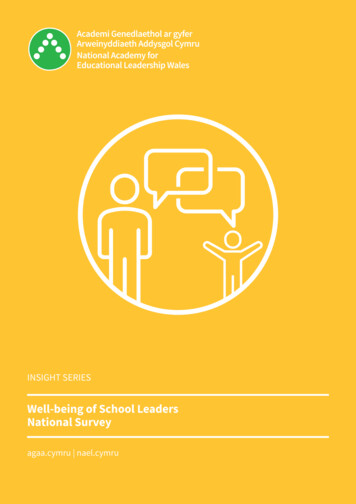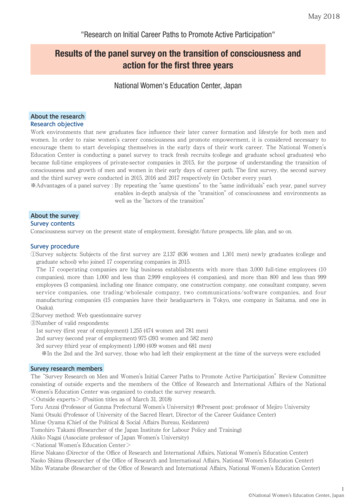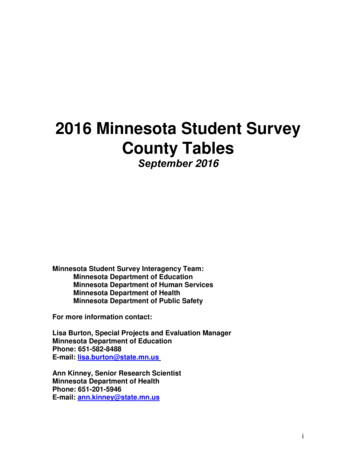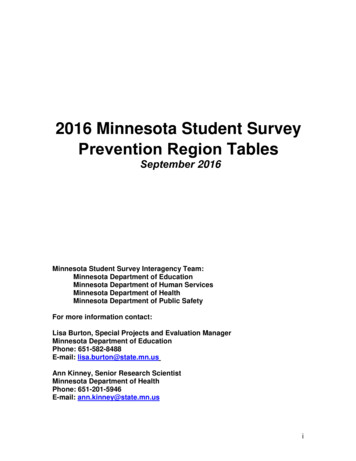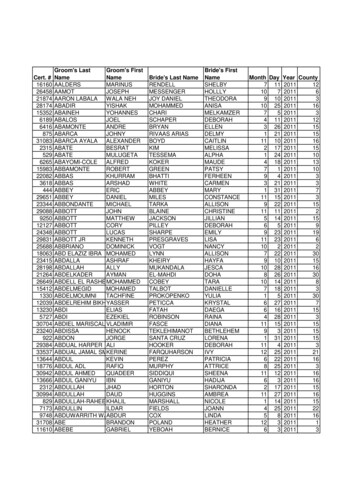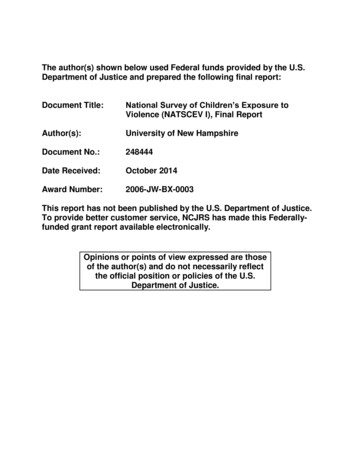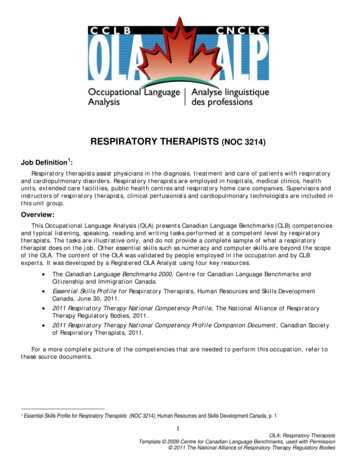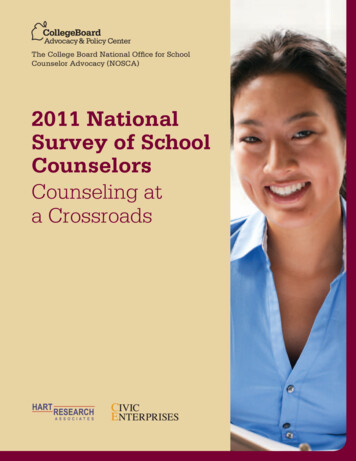
Transcription
The College Board National Office for SchoolCounselor Advocacy (NOSCA)2011 NationalSurvey of SchoolCounselorsCounseling ata CrossroadsHARTRESEARCHA S S O C I AT E S
The Annual Survey of School Counselors was made possible with support from the Kresge Foundation. The College BoardAdvocacy & Policy Center is grateful for the Kresge Foundation’s commitment to this important work.About the Kresge FoundationThe Kresge Foundation is a 2.9 billion private, national foundation that seeks to influence the quality oflife for future generations through its support of nonprofit organizations in six fields of interest: arts andculture, community development, education, the environment, health, and human services. Fosteringgreater access to and success in postsecondary education for low-income, minority and first-generationcollege students is the focus of Kresge’s Education grantmaking. In 2010, Kresge awarded more than 23 million in grants to support higher education in the United States and South Africa.For more information, please visit www.kresge.org
2011 NationalSurvey of SchoolCounselorsCounseling ata CrossroadsJohn BridgelandMary BruceProduced for the College Board Advocacy & Policy Center byHARTRESEARCHA S S O C I AT E SNovember 2011
ContentsAn Open Letter to the American People4Executive Summary5Counseling at a Crossroads10Survey Overview12Counselors See a Broken School Systemin Need of Reform12Counselors Provide Unique, UnderutilizedContributions to Schools21Counselors Are Supportive of CertainAccountability Measures31Counselors Contribute to College andCareer Readiness32Paths Forward38In Schools and Communities38In States39In the AppendixesAppendix 1: Profile of School Counselors45Appendix 2: Civic Marshall Planto Build a Grad Nation51Bibliography53
4 Counseling at the CrossroadsAn Open Letter to theAmerican PeopleSchool counselors are highly valuable professionals inthe education system, but they are also among the leaststrategically deployed. This is a national loss, especially giventhe fact that school counselors are uniquely positioned,in ways that many educators are not, to have a completepicture of the dreams, hopes, life circumstances, challengesand needs of their students. Counselors have both a holisticview of the students in their schools and the opportunity toprovide targeted supports to keep these students on track forsuccess, year after year.For the past century, counselors have been hard at workperforming many roles in their schools, from guiding studentdecision making, helping students to address personalproblems and working with parents, to administering tests,teaching and filling other gaps unrelated to counseling.Counselors’ roles have been as diverse as the studentsthey serve, often resulting in an unclear mission, a lackof accountability for student success, and having schoolcounseling seen as “a profession in search of identity.”1Consequently, even though there are nearly as many schoolcounselors as administrators across America,2 counselorshave been largely left out of the education reform movement.We are at a crossroads in American education in defining therole our nation’s school counselors will play to help improvestudent achievement. America is fast losing its place in theworld in the highest levels of educational attainment. Thecosts to students, communities, the economy and our nationmerit an urgent national response — one that includes ourcounselors. At a time when school district dollars are moreconstrained than ever, and when one in four public schoolstudents fails to graduate on time,3 now is the time to behighly strategic with these precious educational resources.In the pages that follow, we share the perspectives ofschool counselors to better understand how the schoolcounselor, a critical component of the education sector and anunderutilized tool in education reform, can be better leveragedto promote student achievement and ensure more studentsgraduate from high school ready for college and their careers.To understand the perspectives of counselors, the CollegeBoard Advocacy & Policy Center, Civic Enterprises, and PeterD. Hart Research Associates collaborated to survey 5,308middle and high school counselors, which is the largest andbroadest national survey of these education professionals todate. We sought insight into how they view their roles andmissions and spend their days, as we believe they mightbe more strategically deployed to better serve students.We also were interested in their perspectives on measuresof accountability and education policies and practices thatcould strengthen their roles and the systems in which theywork. We hoped to learn what challenges they face and whatsolutions might be found to better leverage the extraordinaryresource that school counselors represent.1. Schimmel, C. 2008. “School Counseling: A Brief Historical Overview.” West VirginiaDepartment of Education. Retrieved from: http://wvde.state.wv.us/counselors/history.html2. United States Department of Labor. 2011. “Education Administrators.” Bureau ofLabor Statistics Occupational Outlook Handbook, 2010–2011. Retrieved from: http://www.bls.gov/oco/ocos007.htm; United States Department of Labor. 2011. “Counselors.”Bureau of Labor Statistics Occupational Outlook Handbook, 2010–2011. Retrievedfrom: http://www.bls.gov/oco/ocos067.htm3. Balfanz, R. et al. 2010. Building a Grad Nation: Progress and Challenge in Ending theHigh School Dropout Epidemic. Civic Enterprises.
Counseling at the Crossroads 5Executive SummaryThis survey of more than 5,300 middle school and high schoolcounselors reveals deep concerns within the profession andsheds light on opportunities to better utilize these valuableleaders in America’s schools. The frustrations and hopes ofschool counselors reflect the central message of this report:school counseling as a profession is at a crossroads. Despitethe aspirations of counselors to effectively help studentssucceed in school and fulfill their dreams, the missionand roles of counselors in the education system must bemore clearly defined; schools must create measures ofaccountability to track their effectiveness; and policymakersand key stakeholders must integrate counselors into reformefforts to maximize their impact in schools across America.School counselors believe their mission should be to preparechildren for high school graduation, college and careers,and they report that they are ready to lead in the effort todramatically accelerate student achievement, in school,careers and life.Survey OverviewCounselors See a Broken School System inNeed of ReformCounselors, on average, have high expectations forthemselves, their students, their schools, and the educationsystem, yet reality falls far short of their hopes. Althoughcounselors want a high-quality education for all students,these professionals report a broken system that does notalign with their aspirations. They call for changes to theeducational system, view themselves as leaders in effectingchange, and want more support. More than eight in 10 counselors report that a top missionof schools should be to ensure that all students complete12th grade ready to succeed in college and careers (85percent rated this as a 9 or a 10 on a 10-point scale), yetonly 30 percent of all school counselors and 19 percent ofthose in high poverty schools (as measured by 75 percentor more of the students on free or reduced-price lunches)see this as their school’s mission in reality. Nine in 10 counselors (89 percent rate this as a 9 ora 10) say that the mission of schools should be thatall students, regardless of background, have equalaccess to a high-quality education, but only 38 percentof all counselors and 32 percent in high povertyschools see this as a reality. Counselors in low povertyschools (as measured by 25 percent or fewer studentson free or reduced-price lunches) fare only slightlybetter, with only 39 percent reporting this as a realityin their schools. Nearly all counselors (93 percent) say they supporta strategic approach to promote college and careerreadiness by 12th grade, including 57 percent whostrongly support this approach. However, more thanone in three of all counselors (35 percent) and 43percent of counselors in lower-income schools donot think they have the support and resources to besuccessful at promoting this mission. More than half of counselors (55 percent) say significantchanges are needed in schools, and 9 percent say acomplete overhaul is necessary. Nearly every counselor(99 percent) agrees that they should exercise leadershipin advocating for students’ access to rigorous academicpreparation, as well as for other college and careerreadiness counseling, even if others in the school do notsee counselors in this leadership role.Counselors Provide Unique, UnderutilizedContributions to SchoolsSchool counselors are a vital, but often overlooked partof the education system, playing key roles in supportingstudents in holistic ways. Counselors, nearly half of whom(49 percent) are former teachers themselves, are uniquelypositioned to support student achievement not only becauseof their specialized education, but also because they havea more complete picture of every student they counsel,understanding their hopes and life circumstances, whileworking with them from year to year to help them meet bothacademic and nonacademic needs. More than eight in 10 counselors say the missionof school counselors should be: to address studentproblems so that all students graduate from high school(85 percent rate this a 9 or 10 on a 10-point scale); toensure that all students earn a high school diploma andgraduate ready to succeed (84 percent); and to helpstudents mature and develop skills for the adult world(83 percent). Yet, few say that these goals closely fit themission of their school in reality, including: A 50 percentage-point gap between the ideal and thereality of helping students mature and develop;
6 Counseling at the Crossroads A 41 percentage-point gap between the ideal andthe reality of addressing student problems so all cangraduate from high school; andA 38 percentage-point gap between the ideal andthe reality of ensuring all students earn a high schooldiploma ready to succeed. Three out of four counselors (74 percent) rate theirunique role (one of their two or three most importantcontributions among a list of five) as student advocateswho create pathways and support to ensure all studentshave opportunities to achieve postsecondary goals, whileonly 42 percent say their schools take advantage of thiscontribution (giving ratings of 9 or 10). Three out of five counselors (62 percent) see theirspecialized training to work with the whole studentas a top contribution, but only two in five (40 percent)see this as well utilized in their schools. School counselors give their schools the most creditfor seeing their value in building trusted relationships.Over six in 10 (65 percent) say their uniquecontribution is establishing a trusting relationship withstudents and nearly as many (57 percent) agree thattheir school takes advantage of this skill set. The majority of counselors would like to spend moretime on targeted activities that promote student success,including career counseling and exploration (75 percent),student academic planning (64 percent), and building acollege-going culture (56 percent). More than two outof three (67 percent) would like to spend less time onadministrative tasks. Three-fourths of counselors (75 percent) in highpoverty schools want to spend more time on buildinga college-going culture, compared to 55 percent ofcounselors in low poverty schools; 72 percent inhigh poverty schools want to spend more time onstudent academic planning, versus 63 percent ofcounselors in low poverty schools; and nearly equaland high percentages of counselors in higher-incomeschools and high poverty schools (79 percent versus75 percent) want to spend more time on careercounseling and exploration.More than half of counselors, including 59 percentof middle school counselors and 60 percent of publicschool counselors, want to spend more time buildinga college-going culture. Counselors are largely divided, however, on whereto spend their time to advance equity in education,with 52 percent saying each student should receiveequal amounts of support and attention and 48percent wanting to target students with the greatestchallenges. Although the majority of counselors have amaster’s degree (73 percent) and important priorwork experience (58 percent were teachers oradministrators), only a small minority feel very welltrained for their jobs (only 16 percent rate their trainingas a 9 or 10 on a 10-point scale). Nearly three in 10 (28percent) believe their training did not prepare themwell for their job and more than half (56 percent) feelonly somewhat well trained. The majority of counselors have sought out additionaltraining in targeted areas to promote studentachievement, including in technology use (75 percent);in college and career counseling (68 percent); infederal and state policies for reporting abuse (59percent); and in learning styles, special educationregulations and understanding test results (58 percentin each case).Counselors Support Certain AccountabilityMeasuresIn an era of data-driven education, counselors will only beviewed as critical assets in education and relevant to thereform agenda once they are accountable for student successin schools. They must be responsible for defining theircontribution and responsibility — and for presenting how theycan be part of existing measures of accountability. Counselorssupport multiple measures of accountability that align withtheir views of their mission and unique role. The majority of high school counselors endorse certainaccountability measures as fair and appropriate (witha rating of 6 to 10 on a 10-point scale) in assessingcounselor effectiveness, including measuring their ownsuccess, based on: Transcript audits of graduation readiness (62 percent); Completion of college-preparatory course sequence(61 percent);
Counseling at the Crossroads 7 Students’ gaining access to advanced classes/tests(60 percent); High school graduation rates (57 percent); and College application rates (57 percent). More than six in 10 counselors (61 percent) supportaccountability measures and incentives for counselorsto meet the 12th-grade college and career-ready goal,with African American counselors (50 percent) twiceas likely as white counselors (25 percent) to stronglysupport creating these measures and incentives. Thisproposal also garners stronger than average supportamong counselors in urban public schools (32 percentstrongly support), schools with high minority populations(44 percent), and schools with lower-income students (38percent). There is less support for other specific measures ofaccountability, with only a minority of high schoolcounselors endorsing measures of effectiveness as fairand appropriate (with a rating of 6 to 10 on a 10-pointscale), such as: College acceptance rates (46 percent); FAFSA completion rates (40 percent); and Dropout rates (37 percent). The majority (55 percent) of middle school counselorsendorse middle school completion rates as a fair andappropriate measure of effectiveness (with a rating of 6 to10 on a 10-point scale). Nearly half of middle school counselors (47 percent)accept high school graduation rates as an appropriateaccountability measure. Four in 10 middle school counselors (40 percent)rank college acceptance rates as fair and appropriatemeasures of counselor effectiveness, even thoughmiddle school counselors are working with studentsup to seven years before college acceptancedecisions would be made.Counselors Contribute to College and CareerReadinessOnly 44 percent of high school freshmen and 69 percentof recent high school graduates enroll in a postsecondaryinstitution.4 Even fewer graduate. Counselors are uniquelypositioned to help reverse these trends, restoring America’sstatus as first in the world in college attainment. Counselorshave strong views on areas ripe for reform: When asked to rate reform proposals, nearly allcounselors (95 percent) are in favor of additional support,time and empowerment for leadership to give studentswhat they need for college, even outpacing 91 percentreporting support for reducing administrative tasks and 90percent wanting smaller caseloads. Counselors also express strong support for other reforms,including: 88 percent support counselor training to help studentsalign the jobs they want with what the skills they willneed to succeed in those jobs; 87 percent support collaboration among middle/highschool counselors and colleges to build a collegegoing culture; 65 percent support data collection and disseminationon high school graduate career and college success;and 61 percent support the creation of accountabilitymeasures and incentives for counselors. When provided a college and career readiness framework(the National Office for School Counselor Advocacy’sEight Components), counselors are in favor of all thecomponents, but far fewer rate their school as successfulon each measure. The top-rated components are: More than seven in 10 counselors (72 percent) saythe College and Career Exploration and SelectionProcesses component is very important, yet only 30percent rate their school as successful in achievingthis measure; More than seven in 10 counselors (73 percent) rateCollege and Career Admission Processes as very4. National Center for Education Statistics. 2009. “Table 201: Recent High SchoolCompleters and Their Enrollment in College, by Race/Ethnicity.” U.S. Departmentof Education Institute of Education Sciences. Retrieved from: http://nces.ed.gov/programs/digest/d09/tables/dt09 201.asp?; Mortenson, T, 2008. “PostsecondaryOpportunity.” The National Center for Higher Education Management Systems.Retrieved from: measure 62&year 2008&level nation&mode data&state 0
8 Counseling at the Crossroadsimportant, yet only 30 percent say their school issuccessful; and More than seven in 10 (71 percent) rate AcademicPlanning for College and Career Readiness as veryimportant, but only 34 percent say their school issuccessful.Paths Forward: CounselorsWe are facing a critical crossroads in education reform: forthe first time in our history, this generation of students isat risk of having lower educational attainment than theirparents.5, 6 Schools will need every asset available — especiallyprofessionals in schools who have a complete picture ofstudents and can follow and support them over time — toensure they get the support they need to stay on track tograduate from high school, ready for college and career.With a clear mission, accountability for results, and a clearcontribution to school improvement efforts, counselorscan fulfill their desire to be strong student advocates. Toaccelerate this progress, we must take the following actions:In Schools and Communities Align the Mission of Counselors with the Needs ofStudents. Given America’s high school and collegecompletion crises and accompanying labor market skillsgap, counselors should be leaders focused on keepingstudents on track to graduate high school, ready forcollege and career. The mission of counselors should betightly tied to this goal and roles designed to meet it. Focus Counselor’s Work on Activities that AccelerateStudent Success. Administrators, and other supervisors,should focus the work of counselors on activities thatsupport and improve student outcomes, redeploying lessexpensive, and less highly skilled employees to performadministrative tasks. Target Professional Development Dollars. The NoChild Left Behind Act provides districts with the flexibilityand resources to apply professional development andother funds as states and districts see fit. Our survey5. Time Is the Enemy: The Surprising Truth About Why Today’s College StudentsAren’t Graduating and What Needs to Change. 2011. Complete College America.Retrieved from http://www.completecollege.org/docs/CCA national EMBARGO.pdf6. U.S. Census Bureau. CPS Historical Time Series Tables: Table A-2. Percent of People25 Years and Over Who Have Completed High School or College, by Race, HispanicOrigin and Sex: Selected Years 1940 to 2010. Retrieved from: cps/historical/index.htmlshows that counselors are eager to receive professionaldevelopment, and that these training sessions shouldbe targeted at critical levers like college and careerreadiness, financial aid, and the use of technology topromote these goals. Schools Should Pilot Test Measures of Accountability.With the importance of accountability and the supportamong counselors for measures of effectiveness thatrelate to their mission and their unique role in boostingstudent success, districts and schools should acceleratethe testing of such performance-based measures andreport the results. Counselors should be given incentivesto focus on and achieve success on accountabilitymeasures. Coordinate Initiatives with Community-BasedOrganizations. Counselors report tremendousworkloads. There are, however, resources to support theirefforts. Nonprofit and community-based college accessprograms are tremendous assets to students, familiesand schools, but are often staffed with volunteers orprofessionals who are not as well trained as counselors.Counselors should utilize these services to lessen theirindividual workloads and also, when appropriate, beconsidered the point person in schools for coordinatingthese initiatives.In States Align Counselor Education and Training Requirementswith the Needs on the Ground. Counselors indicate thattheir preservice training, while somewhat satisfactory,does not adequately prepare them for the realities theyare facing in schools. Course requirements should beupdated to reflect this reality, including mandatory coursework on advising for college readiness, access andaffordability. Redefine Certification Requirements to AdvanceCollege and Career Readiness from a SystemsPerspective. Counselors are caught betweencrosscurrents asking them to play very different roles,thus limiting their effectiveness. Counselors report apreference for work in which one-on-one counseling ispart — but not all — of their role. Enact and Enforce Caseload Requirements. Asof 2009, only five states met the American SchoolCounselor Association (ASCA) recommended ratio of250 students per counselor (Louisiana, Mississippi, New
Counseling at the Crossroads 9Hampshire, Vermont and Wyoming).7 States that do nothave caseload maximums should create them, and allstates should enforce manageable student-to-counselor- ratios. These efforts could align with reforms that breakup large schools into smaller, more personal learningenvironments.In the Nation Enlist Counselors’ Expertise in the Grad NationCampaign. Counselors have been largely left out of theeducation reform agenda — until now. As one example,counselors will now be enrolled as key members of theCivic Marshall Plan to Build a Grad Nation, contributingtheir expertise to help America achieve a nationalgraduation rate of 90 percent by 2020 and the highestcollege attainment rates in the world. Create and Implement Accountability Measures.Until counselors are accountable for success in ourschools, they will not be viewed as critical leaders inthe system. We need to continue testing measures ofaccountability for counselors from the ground up to seewhat the emerging consensus will produce in terms ofeffectiveness, how progress will be measured, and howcounselors will be held to the standards that are created. Continue Strategic Philanthropic Investments in theCounseling Profession. Some national foundations haveprioritized counselors as a strategic investment. Otherlocal and national foundations should follow their lead. Align Federal Legislation, especially ESEA, withHigh-Impact Counseling Initiatives. We expect that afocal point of the upcoming Elementary and SecondaryEducation Act (ESEA) Reauthorization will be to ensurethat students are college and career ready. This shouldinclude a focus on how counselors can be betterleveraged to promote college readiness and academicachievement for the lowest-performing students andreduce the structural barriers to quality college guidance. Expand Research Initiatives Focused on the Efficacyof the Counseling Profession. The body of informationon school counseling consistently shows a field thatstruggles with role definition and measuring efficacy andis inconsistently integrated into or absent from the largereducation reform agenda. Research is particularly limited7. National Center for Education Statistics. 2009. “Common Core of Data.” U.S.Department of Education Institute of Education Sciences.in the areas of technology, accountability, and the role ofcounselors in closing the achievement gap and as leadersin the education system.
10 Counseling at the CrossroadsCounseling at aCrossroadsThe Perspectives and Promise of SchoolCounselors in American EducationThis report of school counseling in America comes at a timewhen the interest in high school graduation and collegeattainment is high and its importance is clearly recognized.Across the country, young people are dreaming about andplanning to attend college in large numbers. A poll releasedin 2005 showed that 87 percent of all young people wantto go to college.8 Young people are not alone in thinkingabout this goal; parents, especially those of minority groupsunder-represented in higher education, also see a needfor postsecondary education. In fact, 92 percent of AfricanAmerican parents and 90 percent of Hispanic parentsconsider college for their children very important, as do 78percent of Caucasian parents.9Often, however, these dreams for the future are not beingrealized. Many young people never enroll in a postsecondaryinstitution and even fewer ever graduate. Current statisticsshow that only 44 percent of high school freshmen and69 percent of recent high school graduates enroll in apostsecondary institution.10 These statistics shed light on theseverity of the U.S. high school dropout crisis, with one-fourthof all public high school students and 40 percent of minoritiesfailing to graduate on time.11 Of the students who docomplete high school, only 57 percent complete a bachelor’sdegree within six years, and only 28 percent complete anassociate degree within three years.128. Bridgeland, J. M. et al. 2006. The Silent Epidemic: Perspective of High SchoolDropouts. Civic Enterprises.9. Bridgeland, J. M. et al. 2008. One Dream, Two Realities: Perspectives of Parentson America’s High Schools. Civic Enterprises, citing a poll released by MTV and theNational Governors Association.10. National Center for Education Statistics. 2009. “Table 201: Recent High SchoolCompleters and Their Enrollment in College, by Race/Ethnicity.” U.S. Departmentof Education Institute of Education Sciences. Retrieved from: http://nces.ed.gov/programs/digest/d09/tables/dt09 201.asp?; Mortenson, T. 2008. “PostsecondaryOpportunity.” The National Center for Higher Education Management Systems.Retrieved from: measure 62&year 2008&level nation&mode data&state 0A labor market skills gap accompanies this crisis in highschool and college completion. Unlike a generation ago, themajority of job openings in the next decade will require atleast some postsecondary education.13 Experts estimatethat despite high unemployment rates overall, Americanbusinesses are in need of 97 million workers for high- ormiddle-skill jobs, yet only 45 million Americans currentlypossess the necessary education and skills to qualify forthese positions.14 This skills gap illustrates the importanceof today’s postsecondary credentials and sheds light onwhy postsecondary planning is increasingly an essentialcomponent of not only high-quality school counseling, butalso the U.S. economy and America’s future.Counselors are uniquely positioned to help address thesekey gaps in education and workforce development, giventheir unique position within the school, which allows themto work with the whole child, supporting both academicand nonacademic needs. The research on the counselingprofession, however, is limited. For example, utilizing GoogleScholar, a database that includes America’s largest scholarlypublishers, the search term “teacher” produced more than2 million results, and “superintendent” produced more thanhalf a million. By comparison, “school counselor” producedjust 230,000 results and “guidance counselor” only 116,000.15Counselors are also missing from major education reformdiscussions and initiatives, such as the Grad Nation campaignto boost high school and college graduation rates. To addressthese information and participation gaps, the College Board’sAdvocacy & Policy Center, partnering with Civic Enterprisesand Peter D. Hart Research Associates, launched the largestever national survey of middle and high school counselors.This survey, which gathered the opinions of 5,308 middleand high school counselors, is the first entry in an annualinitiative.The development of the survey and the analysis of thesurvey findings were informed by the most recent andrelevant research available in the field, including more than300 sources ranging from studies to evaluations, surveys tointerviews. The research focused on middle and high schoolcounselors, excluding work on elementary school counselors,private college admission counselors and counselors atcolleges. The research also focused on the counselor’s11. Balfanz, R. et al. 2010. Building a Grad Nation: Progress and Challenge in Endingthe High School Dropout
Counselors See a Broken School System in Need of Reform Counselors, on average, have high expectations for themselves, their students, their schools, and the education system, yet reality falls far short of their hopes. Although counselors want a high-quality education for all students, these professionals report a broken system that does not




